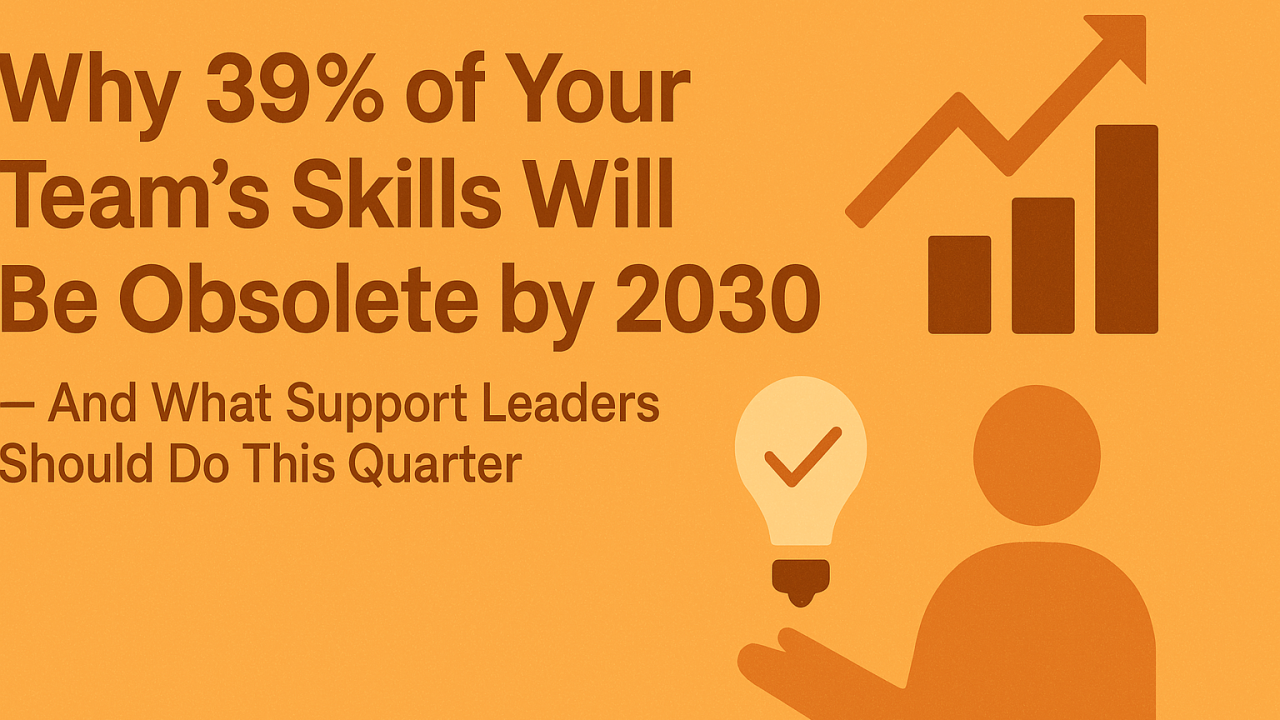🔥 Why 39% of Your Team’s Skills Will Be Obsolete by 2030

The World Economic Forum says 39% of skills used today won’t be relevant by 2030. Here’s how Support Managers can upskill, restructure, and hire smarter—before AI does it for them.
If you're leading a SaaS Support team, chances are some tasks that used to take hours now take minutes with automation or AI. But instead of fearing it, this is your cue to build the most future-proof, value-creating version of your team yet.
Let’s cut through the hype and talk shop. What should you do about it?
Use the Multi-Layer “Why” Framework to audit your team, restructure roles, and rethink hiring before legacy skillsets become dead weight.
🔧 The Manager’s AI Toolkit: Multi-Layer “Why” Framework
Use this framework in 1:1s, planning meetings, or a team workshop. It’s not theoretical—it’s a practical gut-check on every role, workflow, and hire.
✅ Layer 1: Why does this role exist?
- Ask this about every single role on your team.
- Red flag answers: “To reset passwords,” “To reply to tickets,” or “To do QA.”
- Keepers: “To solve user blockers that impact retention,” “To make customer pain visible to product.”
👉 If the role exists because it plugs gaps the product should eventually fix or automate, that’s not job security—it’s a ticking clock.
✅ Layer 2: Why does a human need to do this?
- Can this task be done faster, better, or more accurately by automation or AI?
- Example: If AI can summarize tickets and route them better than a junior agent, do you still need that level of ticket triage?
👉 Answer honestly. This is how you decide what to upskill vs. offload to AI.
✅ Layer 3: Why are we still training for this skill?
Look at your training plans, onboarding docs, and shadowing routines.
- Still emphasizing email templates, canned responses, or tagging systems?
- Better question: Are you training for collaboration with AI, curious problem solving, and empathetic customer escalation?
👉 Training someone into a role or skill AI is about to automate is worse than not training them at all.
🧹 Filter Out the “Out-of-Focus” Skills (According to WEF)
The WEF’s 2025 Future of Jobs report shows several skills in freefall. Here’s a shortlist of what to stop hiring for or over-investing in:

🪴 Retain Through Reinvention: How to Upskill the Right Way
Instead of cutting roles, cut tasks—then give your team the tools to grow into the gaps AI can’t fill:
🔄 Upskill into:
- AI collaboration (prompt design, using AI to summarize/debug)
- Customer empathy and escalation triage
- Product insight + advocacy (translating support trends into feature feedback)
- Creative thinking + workflow redesign
👥 How to Do It Practically:
- Run a “Task Sunset” session: List 5 repeat tasks per role and ask, “Can AI do this now or by next year?”
- Pair each task with a new skill to replace it.
- Use internal SMEs or tools like Coursera, internal AI labs, or shadowing to reskill.
🚦Smarter Hiring: Avoid Dead-End Roles
Let’s not hire someone just to replace a chatbot in 6 months.
Are we hiring for output (tickets closed) or impact (retention, insights, ops)?
Before opening a req, ask:
- Is this role future-compatible with our product and AI roadmap?
- Can this person evolve toward a more strategic role?
- Are we hiring for output (tickets closed) or impact (retention, insights, ops)?
Prioritize hires who are:
- Comfortable navigating change
- Naturally curious + coachable
- Strong at pattern recognition across systems
- Not afraid of AI—they’re already using it
💡 Pro tip: Ask candidates what AI tools they’ve tried and how they use them to learn faster.
🧭 TL;DR — What You Can Do This Week
- Audit roles and ask the 3 Why’s → Kill zombie tasks. Identify roles that add real value.
- Run a skills reset check → Compare your team’s training focus to the “out-of-focus” list above.
- Update your next job description → Focus on adaptability, tech fluency, and customer impact.
- Launch a micro-upskilling program → Start with a 30-minute AI tools sandbox session each week.
🚀 Final Thought
You don’t need to become an AI expert overnight. You just need to be the manager who asks better questions.
Lead the shift. Upskill the willing. Automate the repetitive. And most importantly, keep hiring for the kind of thinking machines can’t replicate.
The future is still human—you just need to rewire what “human value” looks like.

